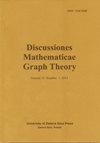正则第二类图中的阻力
IF 0.5
4区 数学
Q3 MATHEMATICS
引用次数: 0
摘要
摘要Vizing的一个著名定理将图分为两类:允许适当Δ-边着色的图,称为第一类图;以及那些没有的,称为第二类图。第二类图确实允许适当的(Δ+1)-边着色。在snark(第二类三次图)的背景下,最近人们非常关注据说用来测量snark离三边着色有多远的参数,因此有许多众所周知的引理和结果被广泛用于snark的研究。到目前为止,这些参数,即所谓的不可回收性测量,在k>3的k-正则二类图的一般情况下,都没有得到考虑。两个这样的度量是图的阻力和顶点阻力。对于图G,G的(顶点)阻力,表示为(rv(G))r(G),被定义为需要从G中移除的最小(顶点)边数,以便将其渲染为一类。本文将一些著名的引理和结果推广到k-正则情形。对于本文的主要结果,我们通过证明k-正则G的以下界来推广r(G)=rv(G)如果G是一个snark的已知事实:rv。此外,我们证明了对于任何偶数k,这两个界都是最佳可能的。本文章由计算机程序翻译,如有差异,请以英文原文为准。
Resistance in Regular Class Two Graphs
Abstract A well-known theorem of Vizing separates graphs into two classes: those which admit proper Δ-edge-colourings, known as class one graphs; and those which do not, known as class two graphs. Class two graphs do admit proper (Δ+ 1)-edge-colourings. In the context of snarks (class two cubic graphs), there has recently been much focus on parameters which are said to measure how far the snark is from being 3-edge-colourable, and there are thus many well-known lemmas and results which are widely used in the study of snarks. These parameters, or so-called measurements of uncolourability, have thus far evaded consideration in the general case of k-regular class two graphs for k > 3. Two such measures are the resistance and vertex resistance of a graph. For a graph G, the (vertex) resistance of G, denoted as (rv(G)) r(G), is defined as the minimum number of (vertices) edges which need to be removed from G in order to render it class one. In this paper, we generalise some of the well-known lemmas and results to the k-regular case. For the main result of this paper, we generalise the known fact that r(G) = rv(G) if G is a snark by proving the following bounds for k-regular G:rv(G)≤r(G)≤⌊ k2 ⌋rv(G) G:{r_v}\left( G \right) \le r\left( G \right) \le \left\lfloor {{k \over 2}} \right\rfloor {r_v}\left( G \right) . Moreover, we show that both bounds are best possible for any even k.
求助全文
通过发布文献求助,成功后即可免费获取论文全文。
去求助
来源期刊

Discussiones Mathematicae Graph Theory
MATHEMATICS-
CiteScore
2.20
自引率
0.00%
发文量
22
审稿时长
53 weeks
期刊介绍:
The Discussiones Mathematicae Graph Theory publishes high-quality refereed original papers. Occasionally, very authoritative expository survey articles and notes of exceptional value can be published. The journal is mainly devoted to the following topics in Graph Theory: colourings, partitions (general colourings), hereditary properties, independence and domination, structures in graphs (sets, paths, cycles, etc.), local properties, products of graphs as well as graph algorithms related to these topics.
 求助内容:
求助内容: 应助结果提醒方式:
应助结果提醒方式:


